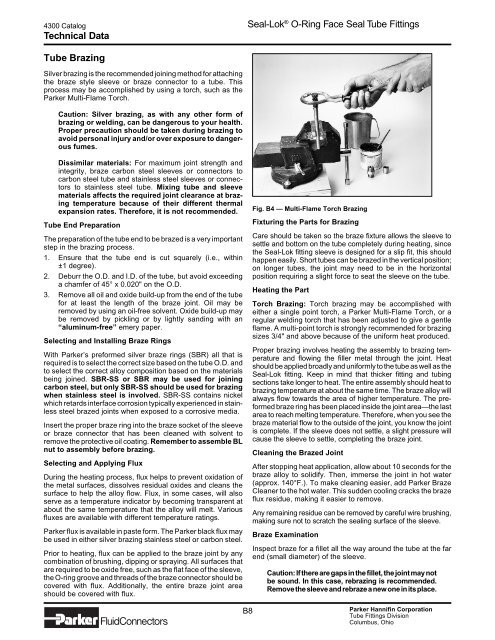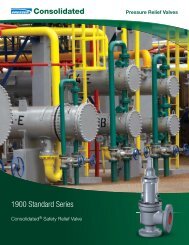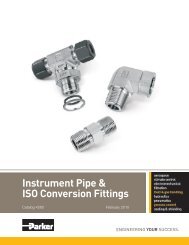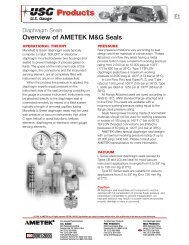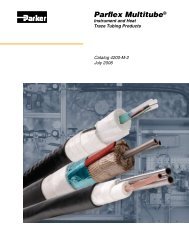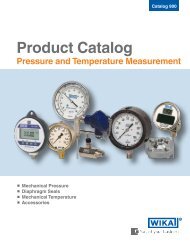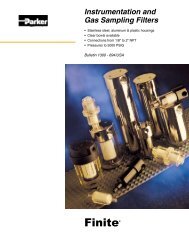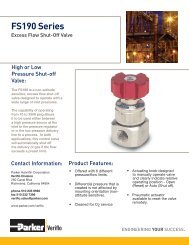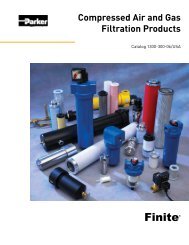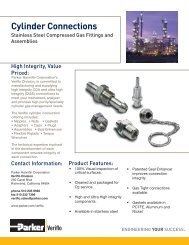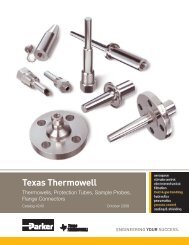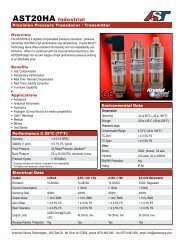Seal-Lok O-Ring Face Seal Tube Fittings - Precision Fitting & Gauge
Seal-Lok O-Ring Face Seal Tube Fittings - Precision Fitting & Gauge
Seal-Lok O-Ring Face Seal Tube Fittings - Precision Fitting & Gauge
- No tags were found...
You also want an ePaper? Increase the reach of your titles
YUMPU automatically turns print PDFs into web optimized ePapers that Google loves.
4300 Catalog <strong>Seal</strong>-<strong>Lok</strong> ® O-<strong>Ring</strong> <strong>Face</strong> <strong>Seal</strong> <strong>Tube</strong> <strong><strong>Fitting</strong>s</strong>Technical Data<strong>Tube</strong> BrazingSilver brazing is the recommended joining method for attachingthe braze style sleeve or braze connector to a tube. Thisprocess may be accomplished by using a torch, such as theParker Multi-Flame Torch.Caution: Silver brazing, as with any other form ofbrazing or welding, can be dangerous to your health.Proper precaution should be taken during brazing toavoid personal injury and/or over exposure to dangerousfumes.Dissimilar materials: For maximum joint strength andintegrity, braze carbon steel sleeves or connectors tocarbon steel tube and stainless steel sleeves or connectorsto stainless steel tube. Mixing tube and sleevematerials affects the required joint clearance at brazingtemperature because of their different thermalexpansion rates. Therefore, it is not recommended.<strong>Tube</strong> End PreparationThe preparation of the tube end to be brazed is a very importantstep in the brazing process.1. Ensure that the tube end is cut squarely (i.e., within±1 degree).2. Deburr the O.D. and I.D. of the tube, but avoid exceedinga chamfer of 45° x 0.020" on the O.D.3. Remove all oil and oxide build-up from the end of the tubefor at least the length of the braze joint. Oil may beremoved by using an oil-free solvent. Oxide build-up maybe removed by pickling or by lightly sanding with an“aluminum-free” emery paper.Selecting and Installing Braze <strong>Ring</strong>sWith Parker’s preformed silver braze rings (SBR) all that isrequired is to select the correct size based on the tube O.D. andto select the correct alloy composition based on the materialsbeing joined. SBR-SS or SBR may be used for joiningcarbon steel, but only SBR-SS should be used for brazingwhen stainless steel is involved. SBR-SS contains nickelwhich retards interface corrosion typically experienced in stainlesssteel brazed joints when exposed to a corrosive media.Insert the proper braze ring into the braze socket of the sleeveor braze connector that has been cleaned with solvent toremove the protective oil coating. Remember to assemble BLnut to assembly before brazing.Selecting and Applying FluxDuring the heating process, flux helps to prevent oxidation ofthe metal surfaces, dissolves residual oxides and cleans thesurface to help the alloy flow. Flux, in some cases, will alsoserve as a temperature indicator by becoming transparent atabout the same temperature that the alloy will melt. Variousfluxes are available with different temperature ratings.Parker flux is available in paste form. The Parker black flux maybe used in either silver brazing stainless steel or carbon steel.Prior to heating, flux can be applied to the braze joint by anycombination of brushing, dipping or spraying. All surfaces thatare required to be oxide free, such as the flat face of the sleeve,the O-ring groove and threads of the braze connector should becovered with flux. Additionally, the entire braze joint areashould be covered with flux.Fig. B4 — Multi-Flame Torch BrazingFixturing the Parts for BrazingCare should be taken so the braze fixture allows the sleeve tosettle and bottom on the tube completely during heating, sincethe <strong>Seal</strong>-<strong>Lok</strong> fitting sleeve is designed for a slip fit, this shouldhappen easily. Short tubes can be brazed in the vertical position;on longer tubes, the joint may need to be in the horizontalposition requiring a slight force to seat the sleeve on the tube.Heating the PartTorch Brazing: Torch brazing may be accomplished witheither a single point torch, a Parker Multi-Flame Torch, or aregular welding torch that has been adjusted to give a gentleflame. A multi-point torch is strongly recommended for brazingsizes 3/4" and above because of the uniform heat produced.Proper brazing involves heating the assembly to brazing temperatureand flowing the filler metal through the joint. Heatshould be applied broadly and uniformly to the tube as well as the<strong>Seal</strong>-<strong>Lok</strong> fitting. Keep in mind that thicker fitting and tubingsections take longer to heat. The entire assembly should heat tobrazing temperature at about the same time. The braze alloy willalways flow towards the area of higher temperature. The preformedbraze ring has been placed inside the joint area—the lastarea to reach melting temperature. Therefore, when you see thebraze material flow to the outside of the joint, you know the jointis complete. If the sleeve does not settle, a slight pressure willcause the sleeve to settle, completing the braze joint.Cleaning the Brazed JointAfter stopping heat application, allow about 10 seconds for thebraze alloy to solidify. Then, immerse the joint in hot water(approx. 140°F.). To make cleaning easier, add Parker BrazeCleaner to the hot water. This sudden cooling cracks the brazeflux residue, making it easier to remove.Any remaining residue can be removed by careful wire brushing,making sure not to scratch the sealing surface of the sleeve.Braze ExaminationInspect braze for a fillet all the way around the tube at the farend (small diameter) of the sleeve.Caution: If there are gaps in the fillet, the joint may notbe sound. In this case, rebrazing is recommended.Remove the sleeve and rebraze a new one in its place.B8Parker Hannifin Corporation<strong>Tube</strong> <strong><strong>Fitting</strong>s</strong> DivisionColumbus, Ohio


